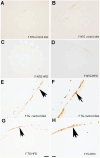Potential link of high fat diet and mRNA expression of Alzheimer's disease-related genes in the enteric mucosa of a rat model of Alzheimer's disease
- PMID: 40809919
- PMCID: PMC12344242
- DOI: 10.1177/25424823251358414
Potential link of high fat diet and mRNA expression of Alzheimer's disease-related genes in the enteric mucosa of a rat model of Alzheimer's disease
Abstract
Background: High-fat diet (HFD) consumption is linked to Alzheimer's disease (AD). Identifying changes in the mRNA expression due to the ingestion of HFD in the intestine-often called the second brain due to its dense enteric neurons-could offer insights into AD development and progression.
Objective: This study assesses whether the introduction of HFD at adult-age influence expression of AD-related genes in the intestines of Wild-type (WT) or the amyloid precursor protein/presenilin1 (APP/PS1)-overexpressing Transgenic (TG) rats.
Methods: Twelve-month-old WT and TG rats (male and female) were fed a control diet (CD; 8% energy from fat), or HFD (45% energy from fat) for six months. Ileal tissues were assessed for the mRNA expression of genes responsible for development/progression of AD.
Results: The WT HFD-fed rats (compared to CD-fed rats) showed increased mRNA expression of genes involved in the development of AD. In contrast, the TG HFD-fed female group, showed a higher number of upregulated genes compared to their respective CD-fed TG group. In TG HFD-fed rats there was higher mRNA expression of genes crucial for synaptic transmission such as Brain-derived neurotrophic factor in females and Choline acetyltransferase in males. Expression of Plasminogen was higher in HFD-fed TG female rats and HFD-fed WT male rats. Overall, the HFD-fed WT male showed mRNA expression of genes involved in the development of AD. However, HFD-fed TG females were more vulnerable for the progression of AD. It is likely that the enteric Plasminogen plays a major role in gut-brain axis for the development of AD in WT male, and progression of AD in TG female during the consumption of HFD.
Conclusions: The consumption of HFD perturbed the expression of enteric genes known to be involved in amyloid-β generation, clearance, and degradation, in a sex-dependent manner.
Keywords: APP/PS1-overexpressing transgenic; Alzheimer's disease; gastrointestinal tract; gut-brain axis; high fat diet; mRNA expression; rat transgenic model.
© The Author(s) 2025.
Conflict of interest statement
The authors declared no potential conflicts of interest with respect to the research, authorship, and/or publication of this article.
Figures










References
-
- Waheed A, Ghaffar M, Mustafa S, et al. Nutrigenomics and neurological disorders: exploring diet-brain interactions for cognitive health. Neurogenetics 2024; 26: 10. - PubMed
LinkOut - more resources
Full Text Sources
Miscellaneous

